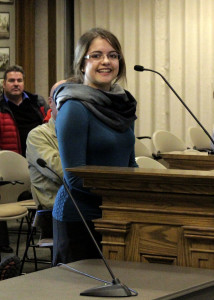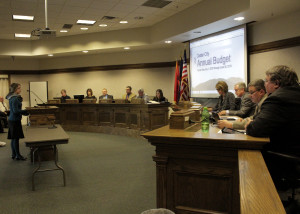
CEDAR CITY — Though Wednesday’s 4 p.m. Cedar City Council meeting was kept brief in anticipation of the “65th Annual Best of Cedar City Awards” to follow, it was jam-packed with important community issues and information for the general public.
Budget presentation

City intern Katrina Arnell, a Cedar High School senior, kicked off the evening’s discussions by presenting an overview document of the 2015-2016 Annual Budget she had prepared at the mayor’s request. The document details each city department, their functions and budgetary requirements.
“It was very eye opening to see how many hours and how many people went into making our community function,” Arnell said. “And I hope that everyone that has the chance to read the document will get that same understanding and appreciation for all that goes on in our community.”
The 57-page document was not easy to compile, Arnell said. While some departments had 20 pages of documentation explaining who they were, what they did and how they functioned, others had only one or two pages.
Many of the departments formatted things differently, she said, and it was up to her to meet with each department head to gain a clear understanding of how it ran.
“I think my favorite part was working with the Fire Department,” Arnell said. “Because I got to go and play with all the cool equipment they have and see all the stuff they had going on.”

The purpose of compiling the data into a working document was to answer any questions Cedar City residents or employees might have about where funds go and why, Arnell said.
“Hopefully it saves time and confusion,” she said, “and serve(s) those in the community and helps to educate everyone who lives in Cedar.”
The completed document has been given to each department head to review as of Wednesday, Mayor Maile Wilson said.
“This is awesome by the way,” Councilman Ron Adams said to Arnell about the budget. “As I gaze through it — wow! You’ve done a lot of work on it and I think it’s great.”
Adams noted that there were a few corrections that would need to be made, but overall, he said, the effort put into completing the task assigned to her was impressive.
Possible water agreements
Council members and administrators delved into the possibility of entering into a water agreement with Gilbert Development Corporation, which plans to build two 80-megawatt solar facilities 1 mile northwest of the Cedar City Wastewater Treatment Facility.
The agreement would allow developers to divert up to 1 million gallons of effluent water per day to their projects for continued use as the solar plants are being constructed for the next three years.
Effluent water is the treated water that is funneled out of the facility at up to 2.5 million gallons a day, City Manager Rick Holman said. The water comes from showers, sinks, toilets and other dirty water sources, he said, and is then processed at the water treatment facility and redistributed.
“We have what we call a land application method of disposing of the water,” Holman said. “The city has property and a local rancher has property and we just allow that water to go out on those many many acres that can be used.”
The community would not be losing any needed water by funneling it to the Gilbert site, Holman said, because Gilbert’s 12,000 acres resides atop the same water table that it would be funneling back into already. The agreement would help build revenue for the water treatment facility, he said.
The matter has been set for the consent agenda at next week’s City Council meeting.
City cell phone policies
Before the meeting closed, city employee policy changes were put on the table for consideration by Human Resources and Risk Management administrator Natasha Hirschi — bringing about an in-depth discussion about cell phone use while driving.
New cell phone restrictions have been added to Chapter 16 of the new city policy handbook, Hirschi said. The restriction that was added was based on the Intergovernmental Risk Management Agency’s guidelines established for cities within their insurance pool, she said.
“They score us points on different items and that’s one of the items that will go towards (sic) our reinsurance when they go to give us our premiums,” Hirschi said.
The new policy would require all city employees to use a hands-free device for their cell phone use while driving, she said.
According to the Cedar City personnel policy, while driving a city vehicle or while driving on city business, employees may:
- Talk on their phone using a hands-free device
- View GPS or navigation coordinates
- Use voice commands
- Use the phone during a medical, fire or police emergency, or
- Report a safety hazard or criminal activity
While driving a city vehicle or while driving on city business, employees may not:
- Send, write or read text messages, instant messages or emails
- Dial a phone number; unless stopped
- View or record a video, or
- Enter data into a handheld device
Council members were concerned about how the policy would be enforced and if it would impede services from departments that require the use of handheld devices at times to be efficient.
“In some ways, sometimes you end up causing more of an accident when somebody has to pull over real fast to answer a call,” Councilman Fred Rowley said, pointing out that the policy seemed to be stronger than the state law requires.
State law on distracted driving
Utah law passed in 2014 provides that drivers may not do the following while their vehicles are in motion:
- Compose, read, or send a text message, email, or instant message
- Enter a phone number
- Access or surf the Internet
- View or record images and video
- Manipulate applications on the phone or wireless handheld device
However, drivers may do the following while their vehicles are in motion:
- Answer calls and talk
- Use hands free devices for phones
- Use a GPS or navigation application on a phone if needed
- Report emergencies, road hazards, criminal activity
Legislation introduced during the 2015 general session seeking to modify the 2014 law failed to pass.
Read more:
- Tighter restrictions on distracted driving go into effect at midnight – May 2014
- Lawmakers revisit distracted driving laws, consider changes – 2015 General Session – bill did not pass
Email: [email protected]
Twitter: @STGnews
Copyright St. George News, SaintGeorgeUtah.com LLC, 2016, all rights reserved.